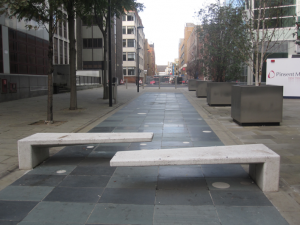Open Cities 30 Steely Closure
Culture of fear
Is it not ironic that a city which broadcasts its openness worldwide is the first to surround itself with a ring of steel? Already one of the most ‘surveilled’ city in the world, the City of London is adding ring after ring of enclosures, thereby turning into a pioneer 21st century fortress. There is no official record of how many CCTV cameras are placed on private buildings, supposedly needed for their self-defence, let alone those placed in the public realm, on public buildings and embedded in street furniture. Estimates have it that anyone walking around the City Corporation is recorded some 350 times. That would be more than enough to become a celebrity if these pictures were in the public domain.
Defenders of this network of surveillance do not see it as a barrier to an open city. Nor do they acknowledge that the ring of steel is exclusive. It is simply a necessity in response to subversive action. In their view the temples of Mammon need extra protection against potential aggressors who dare challenge the ideology of appropriation and greed.
Threats from beyond the gate
This may explain why TINAG, This Is Not A Gateway, www.thisisnotagateway.net was unable to obtain even one square meter inside the ring of steel among the ten million square feet of empty office space in the square mile to launch Volume 2 of Critical Cities, a collection of writings, discourses and photographs on the ‘urban industry’ and its post-critical condition.
http://www.myrdlecourtpress.net/buy_criticalcitiesvol2.html
After lengthy negotiations TINAG were told that their presence would contradict the reason d’etre of the City. The ‘urban industry’ operating in and financed by the City sees itself as builder of gateways. Thus accommodating This Is Not A Gateway among its protagonists was just not possible because ‘Not a Gateway’ would be off-message, shying investors away. This response from within the ring of steel is rather revealing. It means that those who reflect on post-critical urban development, on the nature of gates and exclusion are considered disturbing enough to be kept at bay. They may pride themselves that they seem to be doing something right.
Gating tradition
It could be argued that London was a closed city since its inception during Roman times. Remains of the Roman wall witness that, as well as ruins from medieval times.
In the same tradition, the site bombed during WWII and redeveloped in the nineteen-sixties was conceived as a modern fortress, still difficult of access, a Barbican (barbacana from medieval Latin) endowed with a symbolic historicising gate.
Gating continued, visibly or symbolically as the name Broadgate indicates.
Physical barriers and erosion of open public realm do not necessarily have to occur in horizontal space. They can just as easily be accommodated in the third dimension, within skyscrapers, above public buildings such as railway stations, elevated walkways or, thanks to air rights, across public streets. The City of London contains an imaginative variety of grabbing common spaces, privatising public rights of way, effectively gating what is no longer open space, all the way extending exclusion for its own protection.
Initially put into place in a hurry after the 1992 IRA bombing, the rings of steel are simply an extension of this mental model. They are being perfected through design and technology, while expanding outwards until they will undoubtedly reach the administrative boundary of the square mile and beyond.
Gating beyond
As the City Corporation has extra mural possessions, such as whole sale markets and even blocks of flats, the gating model is being adopted for the transformation of these spaces, for example Spitalfields. Walled and gated cities were a common model as protection against enemy attacks, but most of the walled cities tore down their ramparts when they were subjected to rapid urbanisation. Nevertheless, there may be cultural differences regarding the meaning and need for openness or conversely for real or symbolic enclosure of cities. The notion of ‘my home is my castle’ symbolises an attitude of exclusion, while ‘Stadtluft macht frei’ (city air provides freedom) may point in the opposite direction.









